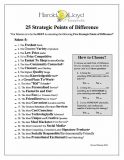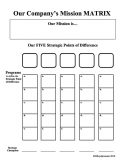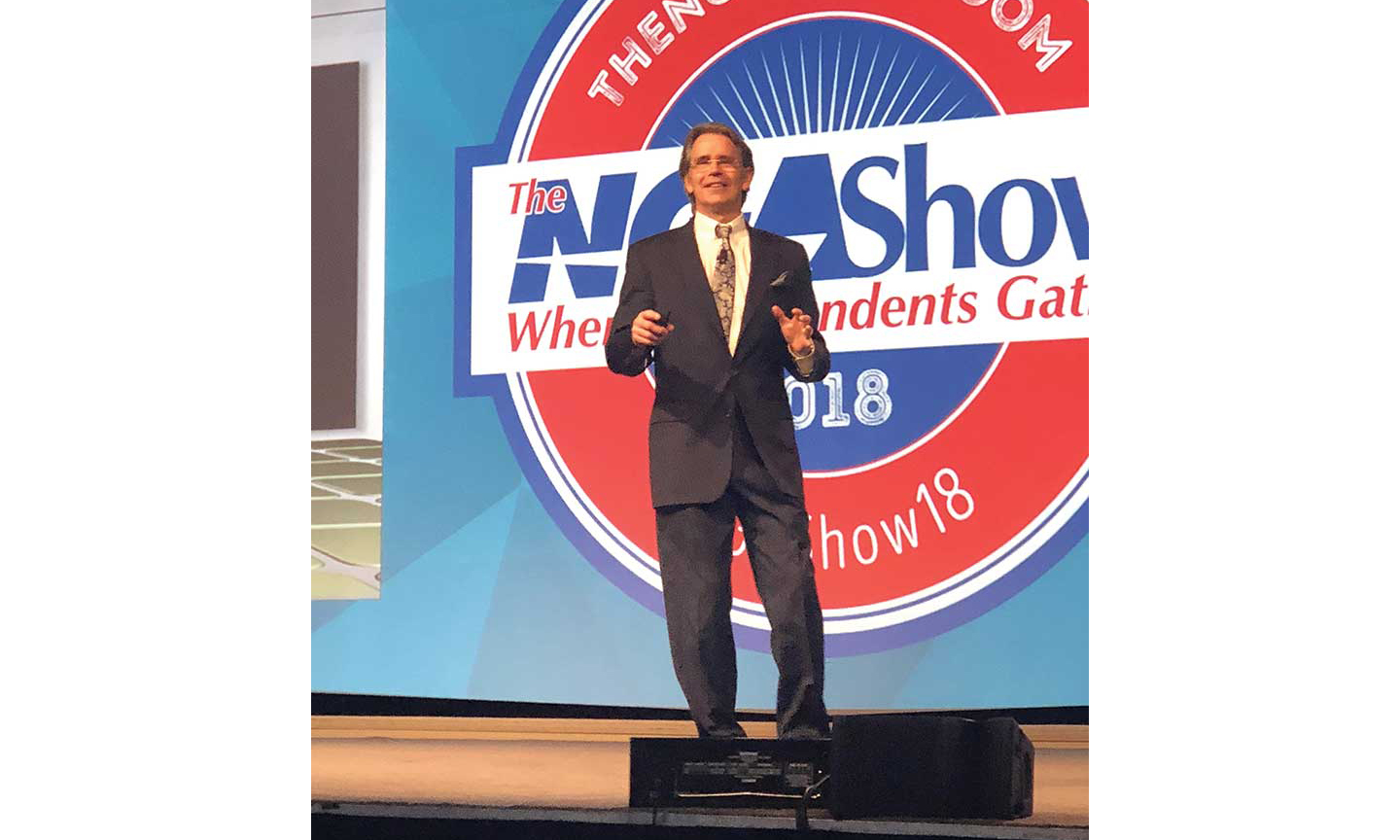by Lorrie Griffith/editor-in-chief
Educator Harold Lloyd presented a Super Breakfast Session at the NGA Show in Las Vegas in February. The agreed-upon title of his presentation was “How to Coexist with the Hard Discounter,” but Lloyd gave an alternative title, too: “How to Remain Relevant.”
“It’s something we all face,” said Lloyd, who is reminded of this as he turns 65 in August. “You want to continue to be relevant in the world and in your career and as a family member.”

Lloyd, through his company Harold Lloyd Presents, has been an educator (and observer) of the industry for 32 years, and this experience has yielded a list of 25 points of differentiation he has seen in places that sell food, including traditional grocers, convenience stores, discounters, clubs, online sites, etc. There’s always a new “scary” competitor on the horizon, he said.
“There will always be one of these new things (coming against) us, and somehow we keep surviving, but sometimes it’s not that easy,” he said. “It’s scary without a focus; it’s scary if you don’t have an identity. There’s no magic wand, there’s no ‘easy’ button and there are no silver bullets on this one. The ones who are really doing well have earned it. And these competitors will help us have to earn it now.
“And hope is not a strategy.”
From that list of 25 differentiators, Lloyd believes grocers need to pick five and become “freaky good” at each of them.
Some highly successful grocers already model this approach.
Publix’s points of difference are 1, 7, 8, 10 and 12.
Wegmans: 1, 9, 10, 21 and 23.
Dorothy Lane Market: 1, 9, 12, 21 and 23.
“These three guys are good at everything, but they’re freaky great about five things,” Lloyd said.
Lloyd, who lives in Virginia Beach, said it took him a few visits to Lidl to figure out its five, but he did: 3, 8, 13, 14, 23.
“They are the low-price leader,” he said. “There is 10 percent market price reduction when they move in; on the categories they have, it’s up to 25 percent.”
They have an image for high quality (8); they have the fastest in and out checkout (13) “and they have aisles that are like 12 feet wide.”
Shopping at Lidl is like a treasure hunt (14); “they have 14,000 items and the items change, you never know what you’re going to get. I haven’t had anything from there that wasn’t delicious,” Lloyd said, including their signature products (23).
How to choose your five
The first step is to meet with the store/company leadership team to determine the five strategic points of difference. At the meeting, present the 25 points of difference list. The gray box on the sheet is a guide of how to choose which strategy is right for that particular company.
Lloyd says any “no” to a gray box question disallows that strategy.
“But if, 1, you have the heart; 2, customers have the want; and 3, you have the ability, bingo—we have a perfect strategy for us.”
Gary and Terrie Baker, owners of five Baker’s IGA stores in Ohio, who this year were named the IGA International Retailers of the Year, already have walked through the process with Lloyd.
Terrie explained their process during Lloyd’s presentation. First, they called a training session for all their department managers, with the Bakers and their GM, Mark, also in attendance.
“We went through and looked at those 25 points and said, what are we going to be different in, what are we really good at? As we went through that process, we had Post-It notes all over the walls. As we went through, everybody had their chance to basically say, ‘We’re best at this, we’re best at that.’”
The department managers then voted on the five; Gary, Terrie and Mark did not vote.
“The interesting thing is, we sat at a separate table and circled our key points of difference. Guess what? They were all the same,” she said.
How to implement your five

After the five strategic points of difference are chosen, the next step is to fill in your company’s “Mission Matrix.”
“This grid looks a little overwhelming, but when you start breaking it down and narrow down to those five points of differentiation, it begins to start to come together,” Lloyd said.
He encourages retailers to create a 25-page binder “that will guide the rest of your history.”
The first page is the company’s mission statement. Page 2 is strategy 1, program 1; page 3 is strategy 1, program 2, etc.
Lloyd said if he were to go back into the food retailing business today, this would be his mission statement: “To offer all of our guests a uniquely satisfying combination of delicious foods, really nice people and delightful surprises each and every time they visit. We are an employer dedicated to its people. We work diligently to ensure our employees are treated with the utmost respect and be given opportunities to grow personally and professionally. We will be a store that is passionately connected to its community through personal involvement in shared events, bringing people together with good food and an enjoyable experience.”
To be connected to the community, for example, every month he would invite a classroom of kids to visit the store.
When he was a retailer, he actually did that, he said.
“Every major department had a little event for the kids to see. I had a big map of the world behind the produce case and an easel hidden behind it. The produce manager would set up the easel and put the map of the world on the easel and take a banana and show them where it comes from. A kiwi…the teachers loved us because we’re taking real life and making a school lesson out of it,” Lloyd said.
For the Bakers, their first step after delineating its five was to start “identifying things that we do, or things we can do, to support what we’re doing in that area,” Terrie said. “One of the areas was ‘let’s be the best place to work.’ So we decided not to have evaluations, not performance reviews, but ‘success plans.’ I can tell you, it is hard to start it; we’ve had training on how to do a proper success plan. I can tell you, a year and a half later, it was one of the smartest decisions we made. If you ask my staff—and we do ask them the best thing we did—they will say, ‘starting success plans.’ Because we really began to listen to our associates and how they made a difference in our company.”
Another of its five was 12: The Most Personalized Service, so they set out to more systematically greet customers.
“We opened up the first checkout, and the cashier said hello to the customers as they came in; whoever manned that checkout was kind of the designated greeter. We also added a cashier at the last checkout. Every time I walk in the store, the last checkout is open, and I say, ‘do you know you have the most important spot in the store?’”
For independent grocers, there are several strategies they can excel at more easily than large chains, such as community involvement; knowledgeable staff; great place to work; kid-friendly; personalized service.
“Twelve of these are ideal for independents; that should be so encouraging to you,” Lloyd said.
Execution is key
As Terrie Baker noted, sometimes implementation is difficult, and Lloyd reinforced that point: “You can’t just pick your five; you have to have flawless execution. Flawless, determined execution. The doctor says you have to exercise and take this pill; you say, I’ll take the pill, but do I have to exercise? This is the exercise seminar. You have to have that exercise; you have to have that flawless execution. It’s attention to detail that you have to own.
“Folks, if you do your five things come hell or high water to a 90 percent execution rate or better, you’ll be bulletproof. Yes, it’s work, like exercising; you’d rather just take the pill. This is work, but this is the answer. It doesn’t have to be what you’re great at now; it can be what you want to be great at, too. Starting today, we’re going to start getting greater, and in two or three years, we’ll be great at it—when we focus every bit of our money, time and attention and brain power to these.”
He continued, “If there are two words you get out of this session, it’s unified focus. The more unified we are on our focus, the more power we have. Unified focus has to be our goal in our organizations, small or large. The key to success is to focus your shots. I think the reason for failure is that we scatter our shots.”
‘Stand-out’ ideas
Lloyd shared some ideas retailers might want to consider implementing as they focus on their five things.
• Extend “bag hunger”-type promotions to year-round. “Hungry people are still hungry after Christmas, so keep it going. Offer two different price points for food bags and a different colored bag for pets.”
• Hold two “team huddles” every day: morning and 4:30 p.m. “One employee from every department stands in a circle for a 10-minute huddle. Everybody gets one minute, and we brief each other about how the day is going or how it’s going to go. Who needs help? What’s new?”
• Do cross-training. “It’s an untapped resource for you, and it eliminates boredom…I asked 20 employees of Lidl, what do you like most about Lidl? A lot of them said, ‘we’re not stuck in any one spot; we do the whole store.’ No one is hired to do anything; they’re hired to do everything. They should scare you. They have a good pay rate, and there’s not one employee who had a bad word to say about this new company coming in.”
• Have employees face “upstream”—toward the normal flow of customer traffic—when they are stocking shelves, etc. “It makes your store seem friendlier.”
• Have every employee “donate” 15 minutes per shift to the store. “The seafood guy takes a tray of cookies or shrimp samples or whatever and walks around the store. It’s a way to get employees out and about, greeting the customer. If we have 40 employees working a shift, that would be 10 hours of coverage—someone roaming the store being nice to people. A customer who is engaged by an associate—sincerely—spends 18 percent more than one who isn’t.” Sincere engagement examples: “do you want me to slice this thinner for you?” “Can I help you with that?” “Thank you very much for shopping with us today.”
• Offer a perk for customers, like infused water. “Use produce that is on its way out and float it in water at four stations around the store. A customer who drinks or eats something spends up to 50 percent longer in the store. You have to have a trash can, you have to keep it looking nice—that’s the flawless execution I’m talking about.”
• A popcorn machine; “it’s fresh, it’s fun. I can make flavors nobody else has. It’s high profit and absolutely fun to have in the store.”
• “Own” the new item market. Put 6-inch, perpendicular-to-the-shelf stickers on every new product—200 or 300 of them. “New items are fabulous, high profit, make me look fresh, make me look exciting.”
• A kids club program that offers rewards; perhaps a treasure chest at every register where the kid gets a prize.
• Place four to six hand basket stations around the store. Put the stacks—each station with a different colored basket so it’s clear where to return it—on a base with a sign that says, “For your convenience, grab a basket.” The top basket is cocked at a 45-degree angle so it suggests to the customer to take it; put a copy of your ad in every basket.
Editor’s note: Lloyd is available as a consultant for companies looking to implement their five strategies. Email him for more information: [email protected].
Keep reading:
Expert Harold Lloyd: Walgreens, Not Walmart, Is The Competition
https://www.theshelbyreport.com/2016/11/18/grocery-guru-center-store-ideas/
https://www.theshelbyreport.com/2017/07/03/supermarket-mgmt-2-0-batenic/

